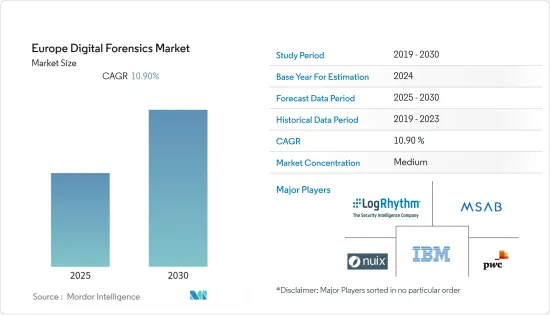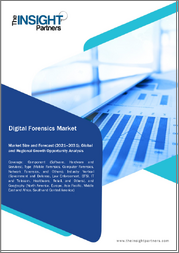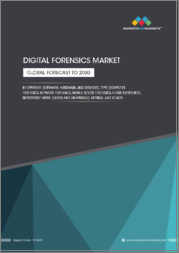
|
시장보고서
상품코드
1639499
유럽의 디지털 포렌식 : 시장 점유율 분석, 산업 동향 및 통계, 성장 예측(2025-2030년)Europe Digital Forensics - Market Share Analysis, Industry Trends & Statistics, Growth Forecasts (2025 - 2030) |
||||||
유럽의 디지털 포렌식 시장은 예측 기간 동안 CAGR 10.9%를 기록할 것으로 예상됩니다.

주요 하이라이트
- 디지털 포렌식의 대부분은 데스크톱, 노트북, 하드 디스크, 플로피 디스크, 광디스크 등 관련 미디어에 집중되어 있지만, 휴대폰 및 기타 핸드헬드 기기를 포함한 다른 유형의 디지털 포렌식도 디지털 큐레이션 및 보존을 위해 빠르게 보급되고 있습니다. 스마트폰 시장도 공급업체, 모델, 시장 규모가 점차 확대되고 있습니다. 또한, IoT와 클라우드와 같은 기술은 IT 산업에 깊은 영향을 미치고 온라인 세계의 방향을 형성하고 있습니다.
- 이 지역 기업들이 디지털 전환을 추진함에 따라 클라우드의 인기가 높아지면서 여러 부문에서 BYOD 정책이 전면에 등장하고 있습니다. 어디서나 파일 및 기타 데이터에 액세스할 수 있는 클라우드 컴퓨팅 솔루션의 성장으로 인해 서로 다른 위치에 있는 팀 간의 협업이 더욱 쉬워졌습니다. 그 결과, 기업에는 수많은 연결된 디바이스가 존재하게 되었고, 해커의 침입 기회가 증가했습니다.
- 포렌식 전문가는 시스템 업그레이드에 대해 CEO에게 자주 조언하고, 사이버 보안 문제에 대해 직원들을 교육하는 등 기업의 보안을 강화하기 위해 노력하고 있습니다. 데이터 유출은 금융 및 정보 도난으로 이어져 기업의 재정과 평판을 손상시킬 수 있기 때문에 기업은 보안을 위해 포렌식 전문가를 고용합니다.
- 또한, 전 세계적인 팬데믹으로 인해 기업들이 전통적인 업무 방식에서 재택근무로 전환함에 따라 원격 근무 솔루션에 대한 수요가 증가했습니다. 더 많은 안전하지 않은 개인 기기가 기업 네트워크에 연결되면 네트워크 보안을 위협할 가능성이 높아지기 때문에 이러한 변화는 기업의 사이버 보안 관점에서 신중하게 고려해야 합니다.
- COVID-19 사태로 인해 유럽에서도 사이버 보안에 대한 경각심이 높아지고 있습니다. 영국 국가사이버보안센터(NCSC)는 공지와 새로운 지침 보고서를 발표했는데, NCSC에 따르면 코로나바이러스를 취급하는 웹사이트의 등록이 증가하고 있다고 합니다. 앞서 NCSC는 코로나바이러스를 미끼로 순진한 사용자를 악성코드 다운로드에 유도하는 웹사이트를 인식하고 제거하기 위해 새로운 자동화 기술을 도입했습니다. 그 결과, 이러한 활동이 현지 시장에 활력을 불어넣고 있습니다.
유럽의 디지털 포렌식 시장 동향
IoT 기기의 확산으로 디지털 포렌식 솔루션 및 서비스 수요 증가 견인
- 기업과 개인이 필요한 보안 조치를 취하지 않고 인터넷에 기기를 계속 연결함에 따라 사이버 범죄자들은 점점 더 많은 IoT 기기를 악성코드 페이로드를 배포하기 위해 IoT 기기를 사용하고 있습니다. 네트워크화된 장치들의 네트워크를 의미합니다.
- IoT 기술은 다양한 기업들에게 디지털 전환을 가능하게 하고, 새로운 비즈니스 모델을 개발 및 도입하여 현재 업무를 개선할 수 있는 능력을 제공하는 초석이 되고 있습니다. 예를 들어, 기업 및 서비스 제공업체들은 디지털 전환을 지원하는 주요 원동력으로 IoT를 주목하고 있습니다. 따라서 IoT 기기가 더 널리 사용됨에 따라 사이버 위험에 더 취약해져 디지털 포렌식 도구에 대한 수요가 증가하고 있습니다.
- 사이버 범죄자들은 개방형 공격 표면을 노출시켜 더 많은 IoT 기기를 노출시키고 있으며, IoT 기기가 IoT 봇넷의 일부가 되면서 분산서비스거부(DDoS) 공격이 유행하고 있습니다. 예를 들어, Mirai 봇넷은 수십만 대의 IoT 기기를 감염시켜 대규모 네트워크 공격에 협력할 수 있도록 했습니다.
- 시스코의 최신 Visual Networking Index 조사에 따르면, 스마트홈은 향후 몇 년 동안 IoT 연결을 촉진하는 주요 요인 중 하나가 될 것으로 예상되며, 2022년까지 285억 개의 디바이스가 연결되고 그 중 약 50%가 IoT/M2M(Machine-to-Machine)이 될 것으로 예측됩니다. Machine-to-Machine)이 될 것으로 예측하고 있습니다.
- 또한, 스마트홈은 여러 가지 이점을 제공하며, 스마트 시티 구상의 중요한 트렌드가 되고 있습니다. 스마트 미터, 스마트 온도 조절기, 스마트 온도 조절기, 스마트 엔터테인먼트 시스템 등 스마트홈 환경의 여러 IoT 기기는 리소스 제약으로 인해 표준화된 보안 솔루션의 도입이 불가능합니다. 그 결과, 보안상의 우려가 현재 스마트홈의 위협이 되고 있으며, 디지털 포렌식 솔루션이 요구되고 있습니다.
- 미국 소재 소프트웨어 기업 Spiceworks Ziff Davis에 따르면, 북미와 유럽 기업에서 도입했거나 도입 예정인 정보기술 트렌드로는 기가비트 와이파이 네트워크가 가장 많았고, IT 자동화 기술이 그 뒤를 이었습니다. 또한, 2023년에 블록체인 기술을 도입했거나 도입할 계획이 있다고 응답한 기업은 35%에 불과했습니다. 이는 유럽 내 디지털 기술의 성장을 시사하며, 이 지역의 조사 시장에 영향을 미칠 것으로 보입니다.
영국이 큰 시장 점유율을 차지할 것으로 예상
- 범죄 행위의 증가로 인해 영국에서는 디지털 포렌식의 필요성이 증가하고 있으며, OLAF로 알려진 유럽불법행위방지국은 유럽이 디지털 환경에서 디지털 조사를 수행하기 위해 자체적으로 설립하여 사용하고 있는 조사 수단입니다.
- 유럽 전역의 민사 및 형사 사건에서 디지털 포렌식 기술은 증거 확보에 활용되고 있습니다. 하드 디스크와 인터넷 스토리지에 저장되는 데이터의 양이 너무 많아지면서 정부 및 비상장 기업에 대한 공격이 증가하고 있으며, 많은 민간 기업들도 이 기술을 내부 조사에 활용하여 부정한 상황에 대처하고 있습니다.
- 2022년 12월 - HMICFRS(HMICFRS, His Majesty's Inspectorate of Constabulary and Fire &Rescue Services)에 따르면, 잉글랜드와 웨일즈의 경찰은 "디지털 포렌식에 관해서는 기술을 따라잡지 못하고 있다"고 합니다. 라고 합니다. 경찰이 수사가 필요한 2만 5,000대 이상의 기기들을 보유하고 있는 상황에서 디지털 범죄에 대응하고 기술 리소스 부족을 보완하기 위해서는 절차 및 관행의 대대적인 전환이 필요합니다.
- SAS 연구소에 따르면, 현재 통신, 제조, 에너지 유틸리티 부문에서 IoT 기기 사용이 증가하고 있으며, 이로 인해 디지털 포렌식의 필요성이 증가하고 있습니다.
- CBER(Centre for Economics and Business Research)에 따르면 영국의 국내총생산은 2025년까지 2조 6,510억 파운드, 2040년까지 3조 3,610억 파운드에 달할 것으로 예상됩니다. 그러나 코로나바이러스(COVID-19) 사태로 인해 디지털 기술에 대한 투자가 급증했고, 이는 국가 GDP에도 영향을 미쳤습니다. 기술 투자는 영국의 GDP를 2025년까지 2.8%, 2040년까지 약 7%까지 끌어올릴 것으로 예측됩니다. 디지털 인프라와 산업의 성장도 디지털 포렌식 시장을 끌어올릴 것으로 보입니다.
유럽의 디지털 포렌식 산업 개요
유럽의 디지털 포렌식 시장은 아직 통합되지 않은 상태이며, 시장 개척 업체들은 최종사용자 비즈니스에 수용 가능한 제품을 개발하기 위해 파트너십, 합병, 인수합병에 크게 의존하고 있습니다. MSAB Inc., LogRhythm Inc., IBM Corporation, PricewaterhouseCoopers, Nuix 등이 주요 시장 진입 업체로 꼽히며, 최종사용자 비즈니스에 수용 가능한 제품을 개발하기 위해 파트너십, 합병, 인수에 의존하고 있습니다. Nuix 등이 시장 진입 기업의 주요 사례입니다.
- 2022년 10월 - 유럽불법행위방지국(OLAF)의 제23회 디지털 포렌식 및 분석가 교육이 종료되었습니다. 2주간 진행된 이번 교육 과정에서는 주로 각국의 법집행기관 직원들이 컴퓨터 범죄, 디지털 포렌식, 부정 방지 분석 등에 대한 교육을 받았습니다. 수강생들은 오픈 소스 인텔리전스, 리눅스, 모바일 포렌식 교육 과정을 통해 금융 사기 분석, 금융 조사, 암호화폐 거래, 온라인 데이터 교환, OLAF와의 협력 등 다양한 분야의 포렌식 및 분석 업무에 대응할 수 있는 역량을 갖추게 되었습니다. 분석 업무에 대응할 수 있습니다.
기타 혜택
- 엑셀 형식의 시장 예측(ME) 시트
- 3개월간 애널리스트 지원
목차
제1장 소개
- 조사 가정과 시장 정의
- 조사 범위
제2장 조사 방법
제3장 주요 요약
제4장 시장 인사이트
- 시장 개요
- 산업의 매력 - Porter's Five Forces 분석
- 공급 기업의 교섭력
- 소비자의 협상력
- 신규 참여업체의 위협
- 경쟁 기업 간의 경쟁 관계
- 대체품의 위협
- 기술 현황
- COVID-19의 산업에 대한 영향 평가
제5장 시장 역학
- 시장 성장 촉진요인
- 디지털 포렌식 솔루션과 서비스 수요를 견인하는 IoT 디바이스 보급 확대
- 산업 전체의 사이버 범죄와 보안에 대한 우려 상승
- 시장 과제
- 숙련 전문가의 부족과 조직내 사전 계획
제6장 시장 세분화
- 컴포넌트
- 하드웨어
- 소프트웨어
- 서비스
- 유형
- 모바일 포렌식
- 컴퓨터 포렌식
- 네트워크 포렌식
- 기타
- 최종 이용 산업
- 정부와 법집행기관
- BFSI
- IT와 통신
- 기타
- 지역
- 영국
- 독일
- 프랑스
- 이탈리아
- 기타 유럽
제7장 경쟁 구도
- 기업 개요
- MSAB Inc.
- Envista Forensics
- LogRhythm Inc.
- FireEye Inc.
- Guidance Software Inc.(Opentext)
- IBM Corporation
- PricewaterhouseCoopers
- Nuix
제8장 투자 분석
제9장 시장 전망
ksm 25.02.10The Europe Digital Forensics Market is expected to register a CAGR of 10.9% during the forecast period.

Key Highlights
- Other types of digital forensics, like those involving mobile phones and other handheld devices, are quickly gaining popularity for digital curation and preservation, even though the majority of forensics have been focused on desktops, laptops, and the associated media, such as the hard drive, floppy disc, and optical discs. The smartphone market has also been gradually expanding in terms of suppliers, models, and market size. Additionally, technologies like IoT and cloud are deeply influencing the IT industry and shaping the direction of the online world.
- The popularity of the cloud has increased as businesses in the region undergo a digital transformation, pushing BYOD policies to the fore in several sectors. The growth of cloud computing solutions that enable access to files and other data from anywhere has facilitated easier collaboration amongst teams in various places. As a result, a company has many linked devices, which increases the opportunities for intrusion by hackers.
- Forensic specialists work to improve corporate security by frequently advising CEOs on system upgrades and educating staff members on cybersecurity issues. Since data breaches can lead to financial or information theft, harming a company's finances and reputation, businesses hire forensic experts for security.
- Moreover, the demand for remote working solutions increased due to businesses switching from traditional workplace practices to working from home during this global pandemic. With more unsecured personal devices connecting to the enterprise's network, the potential of jeopardizing network security increases, so these changes must be carefully considered in the context of the firm's cybersecurity.
- Throughout response to the COVID-19 outbreak, cybersecurity precautions are also increasing in Europe. Public notice and a new guidance report were released by the National Cyber Security Centre (NCSC) of the United Kingdom. According to the NCSC, there has been a rise in the registration of websites that deal with the coronavirus. Previously, NCSC implemented new automation techniques to recognize and eliminate websites that lure naive users into downloading malware by using the coronavirus as bait. As a result, these activities are fueling the local market.
Europe Digital Forensics Market Trends
Growing Adoption of IoT Devices is Driving the Demand for Digital Forensic Solutions and Services
- Cybercriminals increasingly use IoT devices to distribute malware payloads as businesses and individuals keep connecting devices to the internet without taking the required security precautions. The term "IoT" refers to a network of networked devices with constant connectivity and communication.
- IoT technology serves as the cornerstone for a variety of enterprises by enabling them to undergo digital transformations and giving them the ability to improve current operations by developing and implementing new business models. For example, businesses and service providers have focused on IoT as the primary enabler to support digital transformation. Therefore, as IoT devices become more widely used, they become more vulnerable to cyber dangers, which increases the demand for digital forensic tools.
- By exposing open attack surfaces, cybercriminals are exposing more IoT devices. As IoT devices become part of IoT botnets, distributed denial-of-service (DDoS) attacks are becoming more popular. For instance, the Mirai botnet enabled hundreds of thousands of IoT devices to cooperate on massive network attacks by infecting them.
- According to Cisco's most recent Visual Networking Index research, smart homes are anticipated to be one of the major factors boosting IoT connection in the coming years. By 2022, the business projects that there will be 28.5 billion device connections and that about 50% of those connections will be IoT/machine-to-machine (M2M).
- Additionally, smart homes provide several advantages, a crucial trend in the idea of a smart city. The deployment of standardized security solutions is impossible due to the resource-constrained nature of several IoT devices in a smart home setting, including smart meters, smart thermostats, and smart entertainment systems. As a result, security concerns are currently a threat to smart homes, necessitating digital forensic solutions.
- The most common information technology trend deployed or intended to be adopted in North American and European enterprises was gigabit Wi-Fi networking, followed by IT automation technologies, according to Spiceworks Ziff Davis, a US-based software company. Only 35% of respondents claimed that their business had already used blockchain technology or had plans to do so in 2023. This gives an idea of growing digital technology in Europe, which will influence the studied market in the region.
The United Kingdom is Expected to Hold a Significant Market Share
- Due to the rise in criminal activity, there is a growing need for digital forensics in the nation. The European Anti-Fraud Office, often known as OLAF, is a self-investigating instrument that Europe has created and uses to conduct digital investigations in a digital environment.
- In both civil and criminal cases across the region, digital forensic techniques are being used to create evidence. Numerous commercial firms are using the technology for their internal investigations to deal with fraudulent situations as attacks on governments and private companies increase as a result of the excessive volume of data being saved on hard drives and internet storage facilities.
- In December 2022 - According to His Majesty's Inspectorate of Constabulary and Fire & Rescue Services, police forces in England and Wales "are failing to keep pace with technology when it comes to digital forensics" (HMICFRS). Since the ineffective forces have a backlog of more than 25,000 devices that need to be investigated, a significant shift in procedure and practice is necessary to combat digital crimes and make up for the dearth of technical resources.
- The growing IoT adoption rates in the United Kingdom are also expected to drive the market during the forecast period. According to SAS Institute, the telecoms, manufacturing, and energy utilities sectors are currently increasing the use of IoT devices, which drives the need for digital forensics.
- The UK's gross domestic product is expected to reach GBP 2,651 billion by 2025 and GBP 3,361 billion by 2040, according to CBER (Centre for Economics and Business Research). However, the coronavirus (COVID-19) pandemic boosted digital technology investments, which also had an impact on the GDP of the nation. Investments in technology are predicted to boost the UK's GDP by 2.8 percent by 2025 and by almost seven percent by 2040. The growing digital infrastructure and Industry will also boost the Digital Forensics Market.
Europe Digital Forensics Industry Overview
The market for digital forensics in Europe is only modestly consolidated. Vendors in the market have relied heavily on partnerships, mergers, and acquisitions to develop goods acceptable to the end-user business. MSAB Inc., LogRhythm Inc., IBM Corporation, PricewaterhouseCoopers, and Nuix are a few of the market's main participants.
- October 2022 - The 23rd training for digital forensics and analysts was completed by the European Anti-Fraud Office (OLAF). The two-week course primarily trained workers from national law enforcement organizations and included computer crime, digital forensics, and analysis in anti-fraud. Students will be better able to handle forensic and analysis work in areas like money fraud analysis, financial investigations, cryptocurrency transactions, online data exchange, and collaboration with OLAF thanks to training courses in open source intelligence, Linux, and mobile forensics that are being offered.
Additional Benefits:
- The market estimate (ME) sheet in Excel format
- 3 months of analyst support
TABLE OF CONTENTS
1 INTRODUCTION
- 1.1 Study Assumptions and Market Definition
- 1.2 Scope of the Study
2 RESEARCH METHODOLOGY
3 EXECUTIVE SUMMARY
4 MARKET INSIGHTS
- 4.1 Market Overview
- 4.2 Industry Attractiveness - Porter's Five Forces Analysis
- 4.2.1 Bargaining Power of Suppliers
- 4.2.2 Bargaining Power of Consumers
- 4.2.3 Threat of New Entrants
- 4.2.4 Intensity of Competitive Rivalry
- 4.2.5 Threat of Substitutes
- 4.3 Technology Snapshot
- 4.4 Assessment of the Impact of COVID-19 on the Industry
5 MARKET DYNAMICS
- 5.1 Market Drivers
- 5.1.1 Growing Adoption of IoT Devices Driving the Demand for Digital Forensic Solutions and Services
- 5.1.2 Growing Cybercrimes and Security Concerns across Industries
- 5.2 Market Challenges
- 5.2.1 Lack of Skilled Professionals and Preplanning Among Organizations
6 MARKET SEGMENTATION
- 6.1 Component
- 6.1.1 Hardware
- 6.1.2 Software
- 6.1.3 Services
- 6.2 Type
- 6.2.1 Mobile Forensics
- 6.2.2 Computer Forensics
- 6.2.3 Network Forensics
- 6.2.4 Other Types
- 6.3 End-user Industry
- 6.3.1 Government and Law Enforcement Agencies
- 6.3.2 BFSI
- 6.3.3 IT and Telecom
- 6.3.4 Other End-user Industries
- 6.4 Geography
- 6.4.1 United Kingdom
- 6.4.2 Germany
- 6.4.3 France
- 6.4.4 Italy
- 6.4.5 Rest of Europe
7 COMPETITIVE LANDSCAPE
- 7.1 Company Profiles
- 7.1.1 MSAB Inc.
- 7.1.2 Envista Forensics
- 7.1.3 LogRhythm Inc.
- 7.1.4 FireEye Inc.
- 7.1.5 Guidance Software Inc. (Opentext)
- 7.1.6 IBM Corporation
- 7.1.7 PricewaterhouseCoopers
- 7.1.8 Nuix



















